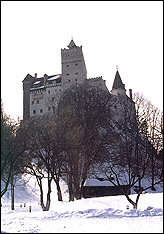 CURIOSITIES CURIOSITIES |
Bram Stoker wrote his world acclaimed novel Dracula in 1897. This fiction story about a Transylvanian Count, who drank human blood to perpetuate his existence was partly inspired on the XV century King of Wallachia, Vlad Tepes, and on widespread Eastern European superstitions about the living-dead. Stoker, who never set foot in Romania, did most of his research in the Irish Library. The much sought after castle of Dracula set up in the novel in the Dorgo Pass (northern Transylvania) never existed. Nevertheless, tourists can today visit what is presented to them as Dracula's castle in the town of Bran, in the southern Carpathian range.

Vlad Tepes, king of Wallachia from 1456 to 1476, is highly admired by Romanians, who consider him a true patriot. He succeeded to keep the Ottomans at bay by impaling as many invaders he could set his hands on. During the battle of Tirgoviste he killed and impaled 20,000 Turkish warriors, leaving a 3 Km. forest of staked corpses. When the next horde of Turks arrived they fled in horror. For this reason Vlad Tepes received the name of Vlad the Impaler. Bram Stoker must have confused Vlad Tepes history with the name of his father, Vlad Dracul, called that way because he belonged to the Order of the Dragon (Dracul). Paradoxically dracul also means devil in Romanian.
|
Johnny Weissmüller, the most famous Tarzan of all times was born in the Romanian town of Timisoara. His family fled to Pennsylvania (USA) at the turn of the century and he never declared to be Romanian. Before impersonating Tarzan, Johnny Weissmüller won five Olympic medals, all of them for his adopted country, USA. He died in 1984.
Ovid, one of the most the most revered Latin poets of its time, author of the Metamorphosis, was exiled to Romania by Roman Emperor Augustus in 16 A.D. The Emperor, offended by Ovid's writings, banished him to the furthestmost corner of the Empire, the city of Tomis, today Constanza, in the Black Sea. There Ovid spent the 9 remaining years of his life asking for the forgiveness of the Emperor, writing some of his saddest compositions (Tristia, Ex Ponto) and complaining about the the mosquitos and the unhealthy weather. He was not forgiven and was never allowed to return to Rome.
Nadia Comaneci was the fist gymnast ever in the history of Olympic games to score a perfect 10. Nadia Comaneci, born in 1961 in Onesti, received seven 10 scores during the 1976 Olympic Games at Montreal, winning 3 gold, 1 silver and 1 bronze medals for Romania. Nadia instantly became the fairy of the Games and the best ambassador for Romania. After retiring in 1984 she defected the country 1989 leaving for the USA. She presently lives in Oklahoma.
Ilie Nastase was the first Romanian number one ranked tennis player in the ATP. Known for his sense of humor and outrageous behavior in the court, Ilie Nastase held his high position from 1971 to 1975. He won the US Open in 1972 and the French Open (Roland Garros) in 1973.
Romania is a Latin island in a Slavic Sea. Surrounded by Slavic countries and Hungary, Romania, called Dacia under the Roman Empire, has retained Latin as the base of its language. Romanian belongs to the same family as Spanish, French, Italian, or Portuguese. But although it is easily understood by any of these Romance language speakers, the influence Hungarian, German or Turkish make Romanian slightly more complicated that it might first seem. |

